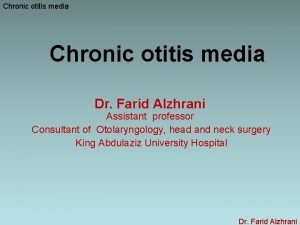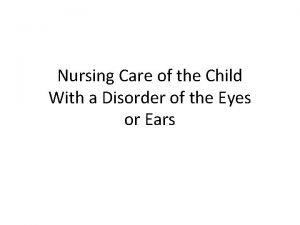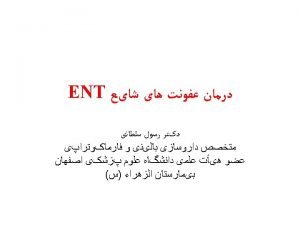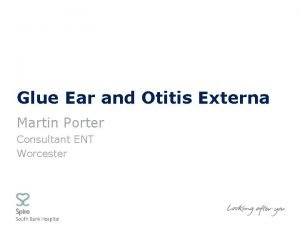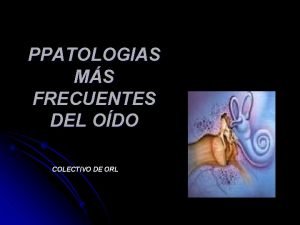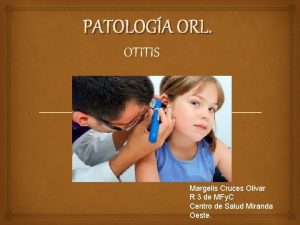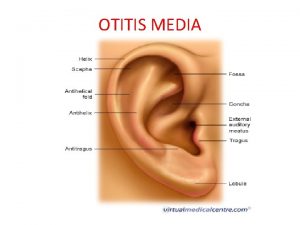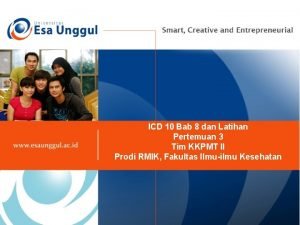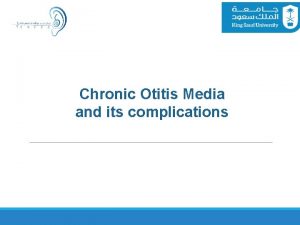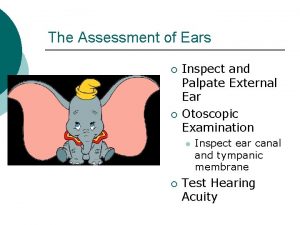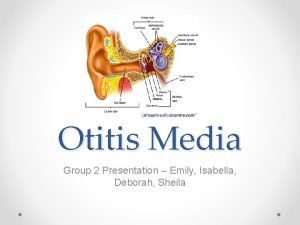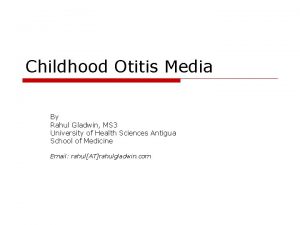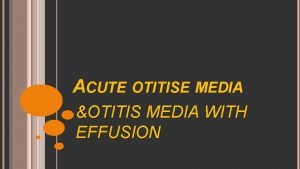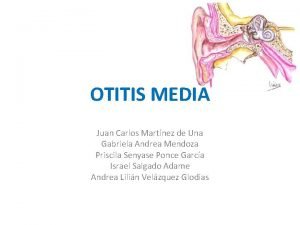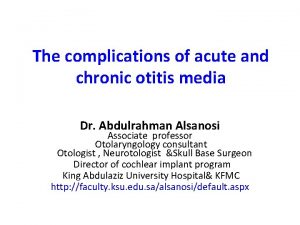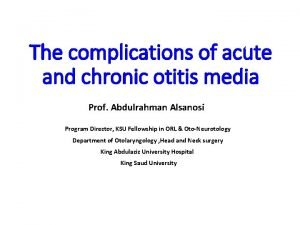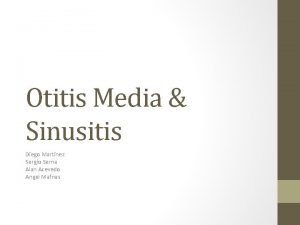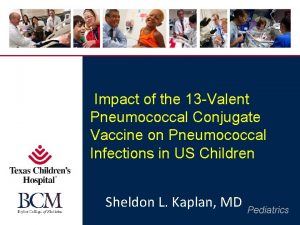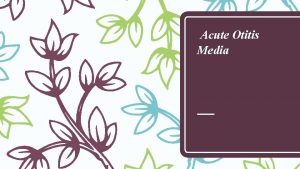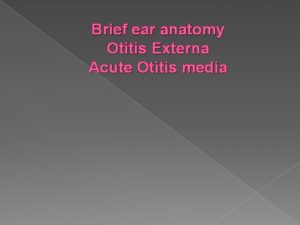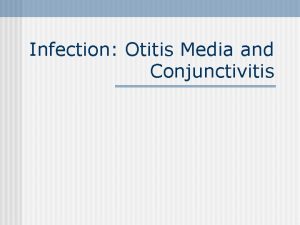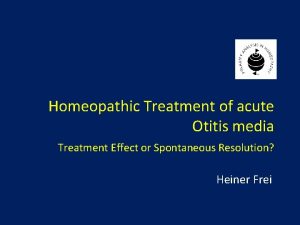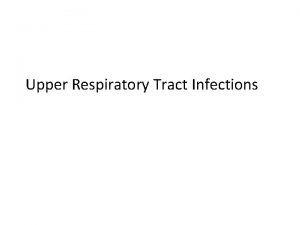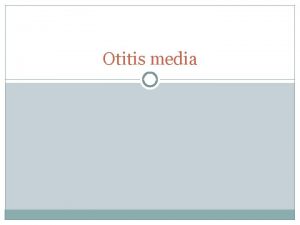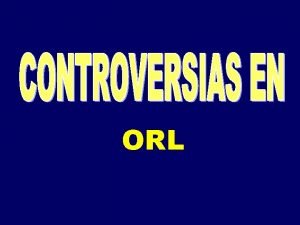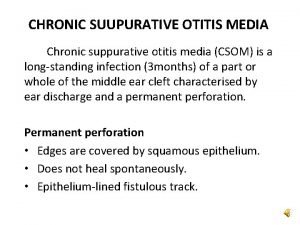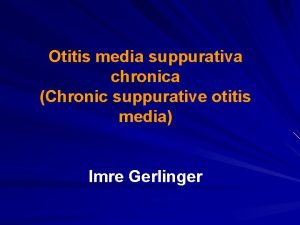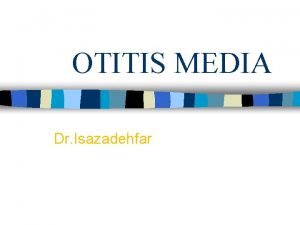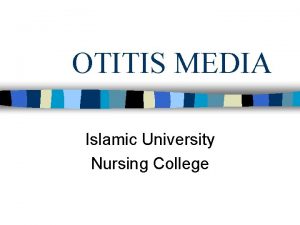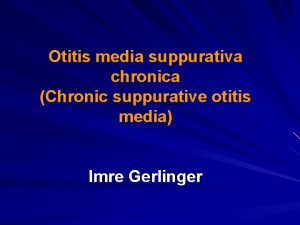Diagnosis and Treatment of Acute Otitis Media Authors





















- Slides: 21

Diagnosis and Treatment of Acute Otitis Media Author(s): Anna Dolgner, MD Level: Basic Academic Affiliation : Duke University School of Medicine Version No: 1. 2 Submitted: March 2012 Editors’ Review: April 2013

2 Disclaimer/Liability • The information provided in the VAP is made available in good faith and is derived from sources believed to be reliable and accurate at the time of release. • The materials presented on the VAP may include links to external Internet sites. These external information sources are outside the control of Duke-NUS. The user of the Internet links is responsible for making his or her own decision about the accuracy, reliability and correctness of the information found. • In no event shall Duke-NUS be liable for any indirect, special, incidental, or consequential damages arising out of any use of reliance of any information contained in the VAP. Nor does Duke-NUS assume any responsibility for failure or delay in updating or removing the information contained in the VAP. • Moreover, information provided on the VAP does not constitute medical advice or treatment nor should it be considered as a replacement of the patient/physician relationship or a physician’s professional judgment. Duke-NUS expressly disclaims all liability for treatment, diagnosis, decisions and actions taken or not taken in reliance upon information contained in the VAP. This work is licensed under a Creative Commons Attribution-Non. Commercial-No. Derivs 3. 0 Unported License To view a copy of this license, visit [http: //creativecommons. org/licenses/by-nc-nd/3. 0/]

3 Financial Disclosures (past 3 years) • No Disclosures

4 Learning Objectives • Learn the symptoms of AOM • Be able to diagnose AOM by exam • Understand treatment and antibiotic choices

5 Outline • Epidemiology • Pathophysiology • Microbiology • Signs and Symptoms • Treatment

6 Epidemiology of AOM • Most commonly occurs ages 6 -18 months – 60 -80% of pts have AOM by 1 year – 80 -90% of pts have AOM by 3 years • Most common reason for antibiotic use in children • Responsible for 16 million office visits in 2000 – About 80% of these visits led to antibiotic prescription • Risk factors include daycare, lack of breastfeeding, tobacco smoke exposure, being member of indigenous (American Indian) population, and + FH

7 Pathophysiology • Definition: Presence of fluid in inner ear associated with signs of illness and middle ear inflammation • Antecedent URI+colonization by pathogenic bacteria inflammation of Eustachian tubes, blocking isthmus secretions accumulate microbial migration and growth AOM

8 Ear anatomy 1 - skull 2 - ear canal 3 - pinna 4 – tympanum 5 - fenestra ovalis 6 - malleus 7 - incus 8 - stapes 9 - labyrinth 10 - cochlea 11 - auditory nerve 12 - eustachian tube http: //commons. wikimedia. org/wiki/File: Ear-anatomy. png

9 Microbiology • Bacteria: the big 3 – Streptococcus pneumoniae (~50%) – Moraxella catarrhalis (~20%) – non-typeable Haemophilus influenzae (~30%) • Special considerations – ~100% Moraxella and ~50% Haemophilus colonies are betalactamase + – 50% S. pneumoniae isolates moderately or highly PCNresistant via PCN-binding proteins

10 Signs and Symptoms • Fever, otalgia, irritability, otorrhea – Fever present in 30 -60% of patients Rare to be >40 degrees C – Otalgia present in about 80% of patients • Can also have non-specific symptoms such as headache, nausea, vomiting, diarrhea • Antecedent/concurrent URI symptoms present in many patients

11 Physical Examination-suggestive findings • Middle ear effusion – Fullness/bulging of TM Best indicator – Reduced/absent TM mobility on insufflation • Erythematous or cloudy TM • Bullae on TM • Pus behind TM • TM perforation

12 Otoscopic evaluation Normal TM http: //upload. wikimedia. org/wikipedia/commons/0/0 b/Tympan-normal. jpg AOM http: //upload. wikimedia. org/wikipedia/commons/6/67/Acute_Otitis_Media. jpg

13 Treatment-symptomatic • Treat fever – acetaminophen or ibuprofen • Treat otalgia – acetaminophen or ibuprofen – Intra-otic therapy Antipyrine-benzocaine (Auralgan) drops

14 Antibiotics-who to treat? • Immediate therapy – <6 months if diagnosis suspected or certain – 6 -24 months if diagnosis certain – Felt to be “severely ill” • Delayed therapy (48 -72 h symptomatic tx) – 6 -24 months if diagnosis uncertain and not “severely ill” and otherwise healthy child – >24 months if diagnosis uncertain or not “severely ill” and otherwise healthy child

15 Antibiotics-preferred • Amoxicillin – First-line for uncomplicated AOM – 80 -90 mg/kg/d to overcome penicillin binding proteins • Amoxicillin-clavulanate – If systemically ill (temp >39 C, severe otalgia) – If suspect beta-lactamase producing organism – 80 -90 mg/kg/d of amoxicillin component to overcome penicillin binding proteins

16 Antibiotics-other considerations If pt PCN-allergic • If mild allergy – 2 nd or 3 rd generation cephalosporin Cefdinir, cefpodoxime, cefuroxime, single dose IM ceftriaxone • If severe allergy (type I) – Macrolides Azithromycin, clarithromycin, erythromycin-sulfisoxazole – Clindamycin – TMP-SMX (less preferred)

17 Duration of Antimicrobial Therapy • Standard duration is 10 days – Except azithromycin (5 days) • Reasonable to consider 5 -7 day course in children >6 with mild to moderate AOM

18 Antibiotic Failure If symptoms do not resolve in 48 -72 hours, suspect resistant infection • Usually beta-lactamase producing organism, but could be unusual organism • Change medication to amoxicillin-clavulanate or aforementioned cephalosporins

19 Summary • Most common ages 6 -18 months • Fever, otalgia, otorrhea +/- concurrent URI are common • See erythematous, bulging TM +/- purulence on exam • Antibiotics can be delayed in lower risk groups – >24 months – 6 -24 months if diagnosis uncertain and child clinically well • Antibiotic choices should target S. pneumo, M. catarrhalis, and H. influenzae and consider illness severity and resistance mechanisms – Common choices are high dose amoxicillin or amoxicillin-clavulanate, 2 nd -3 rd generation cephalosporins, and macrolides

20 Key References • AAP Practice Guideline: Diagnosis and Management of Acute Otitis Media. Pediatrics Vol. 113 No. 5 May 1, 2004 pp. 1451 -1465 • http: //commons. wikimedia. org/wiki/File: Ear-anatomy. png • Klein JO et al. Acute otitis media in children: Epidemiology, microbiology, clinical manifestations, and complications. Up. To. Date Online. Accessed 3/17/12. • Wald ER. Acute otitis media in children: Diagnosis. Up. To. Date Online. Accessed 3/17/12. • http: //upload. wikimedia. org/wikipedia/commons/6/67/Acute_Otitis_Media. jpg • http: //upload. wikimedia. org/wikipedia/commons/0/0 b/Tympan-normal. jpg

Partners in Academic Medicine
 Tubotympanic
Tubotympanic Nursing diagnosis for otitis media slideshare
Nursing diagnosis for otitis media slideshare Nursing management of conjunctivitis
Nursing management of conjunctivitis Laryngitis
Laryngitis Differential diagnosis of otitis externa
Differential diagnosis of otitis externa 09112007 color
09112007 color Clasificación de la otitis media
Clasificación de la otitis media Otalgia manejo
Otalgia manejo Adhesive otitis media
Adhesive otitis media Icd 10 otomycosis
Icd 10 otomycosis Myringplasty
Myringplasty Palpation of ear
Palpation of ear Serous otitis media
Serous otitis media Fluid behind eardrum
Fluid behind eardrum Wikimedia
Wikimedia Cefdinir medscape
Cefdinir medscape Otitis media with effusion otoscopy
Otitis media with effusion otoscopy Tímpano
Tímpano Otitis media complications
Otitis media complications Otitis media ppt
Otitis media ppt Classification of otitis media
Classification of otitis media Streptococcus pneumoniae otitis media
Streptococcus pneumoniae otitis media
